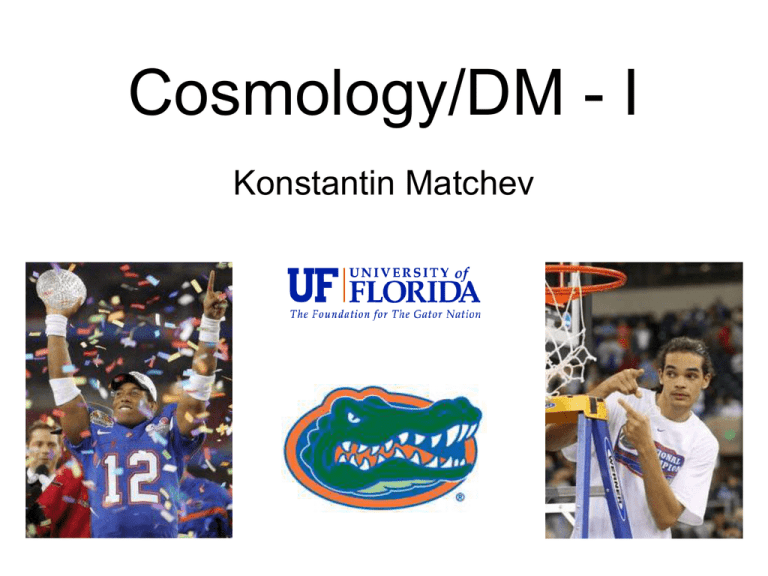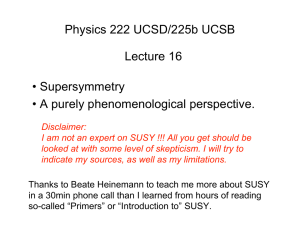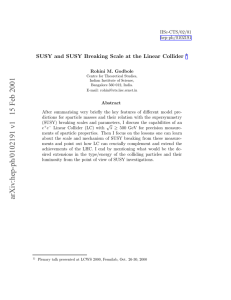Cosmology/DM - I Konstantin Matchev
advertisement

Cosmology/DM - I
Konstantin Matchev
What Do We Do?
• Trying to answer the really big questions:
1. What is the Universe made of?
...
5. Can the laws of Physics be
unified?
…
126. What is the cause of the
“terrible twos”?
• Says who? How about DOE/NSF
(he who pays the piper orders the tune…)
The 9 Big Questions
• Are there undiscovered principles of Nature:
new symmetries, new physical laws?
• How can we solve the mystery of dark energy?
• Are there extra dimensions of space?
• Do all forces become one?
• Why are there so many kinds of particles?
• What is dark matter? How can we make it in the lab?
• What are neutrinos telling us?
• How did the universe come to be?
• What happened to the antimatter?
The need for new physics BSM
Heavy elements 0.03%
DARK MATTER
Known DM properties
• Stable
• Non-baryonic
• Cold
DM: precise, unambiguous evidence
for new particles (physics BSM)
BSM Theory Cookbook
• Two approaches:
– A: Take the SM and modify something.
– B: Ask your advisor how to do A.
• The Standard Model is a
– Lorentz-invariant
– gauge theory based on SU(3)xSU(2)xU(1)
– of mostly fermions
– but also one Higgs
– in d=4
• As a rule, we expect new particles
Dark Matter Cookbook
• Invent a model with new particles
– Supersymmetry
– Universal Extra Dimensions
• Invent a symmetry which guarantees that at least one of
them (the lightest) is stable
• Fudge model parameters until the dark matter particle is
neutral
• Calculate the dark matter relic density
– Use a computer program, e.g. MicrOMEGAs
• Fudge model parameters until you get the correct relic
abundance
• If it works, don’t forget to write a paper
Outline of the lectures
• All lecture materials are on the web:
http://www.phys.ufl.edu/~matchev/PiTP2007
• Yesterday: became familiar with MicrOMEGAs
• Implement the New Minimal Standard Model
(Davoudiasl, Kitano, Li, Murayama 2004)
1
1 2 2 k 2 2 h 4
μ
L S = ∂ μ S ∂ S − m S S − ∣H ∣ S − S
2
2
2
4!
• Today: discuss several new physics models and their
respective dark matter candidates
– concentrate on WIMPs
• Later today: discuss how collider and astro experiments
can
– determine DM properties
– discriminate between alternative models
• Homework exercises throughout today’s lectures
Useful references
•
•
•
•
•
•
•
Jungman, Kamionkowski, Griest, hep-ph/9506380
Bergstrom, hep-ph/0002126
Bertone, Hooper, Silk, hep-ph/0404175
Feng, hep-ph/0405215
Baltz, Battaglia, Peskin, Wizansky, hep-ph/0602187
Murayama, 0704.2276 [hep-ph]
Peskin, 0707.1536 [hep-ph]
DARK MATTER CANDIDATES
• There are many candidates
• Masses and interaction
strengths span many,
many orders of magnitude
• But not all are equally
motivated. Focus on:
– WIMPs: natural thermal
relics
Dark Matter Scientific Assessment Group,
U.S. DOE/NSF/NASA HEPAP/AAAC Subpanel (2007)
Thermal relic abundance - I
• At early times, the DM particles χ and SM particles X are
in thermal equilibrium
χχ ↔ XX
• Freeze-out described by the Boltzmann equation
•
−3 Hn χ
dn χ
2
=−3 Hn χ −⟨σ A υ⟩ n2χ −neq
dt
accounts for dilution due to Hubble expansion
−⟨σ A υ⟩ n2χ describes depletion due to
•
•
2
• ⟨σ A υ⟩ neq describes resupply due to
χχ XX
χχ XX
Thermal relic abundance - II
• σ A is the total DM annihilation cross-section
σ A ≡∑ σ χχ XX ≡abυ 2 ο υ 4
X
• Notice that we do not know the specific final states
• The a-term is the one relevant for indirect detection
(ongoing DM annihilations in the galactic halo)
• Approximate analytic solution
10 9 GeV −1 x F
1
χh =
M Pl
g ¿ x F a3 b/ x F
2
mχ
45 g m χ M Pl a6 b/ x F
x F ≡ =ln c
≈25
3
TF
8 2 π g¿ x F x F
What does WMAP tell us?
• 3 unknowns: χ h2 , σ A=abυ 2 , m χ ; 1constraint
1. Thermal relics make up
all of the DM: χ h2 =0.1
α2
2. Thermal relics are WIMPs: σ A =k 2
mχ
HEPAP LHC/ILC Subpanel (2006)
[band width from k = 0.5 – 2, S and P wave]
Supersymmetry
• Extra dimension, but fermionic (θ’s anticommute)
μ
μ
α
μ
μ
α
Φ x , θ = x ψ x θ α F x θ θ α
• SUSY relates particles and superpartners ↔ψ
• The SM particles and their superpartners have
– Spins differing by ½
– Identical couplings
• Introduce negative R-parity for superpartners
–
–
–
–
Forbids dangerous interactions allowing proton decay
Is it overrated? (do the HW in SUSY lecture1)
No tree-level contributions to precision EW data
Makes the lightest superpartner stable (dark matter!)
DM CANDIDATES IN MSSM
Spin
2
U(1)
M1
SU(2)
M2
Up-type
µ
Down-type
µ
mν̃
m3/2
G
graviton
3/2
G̃
gravitino
Neutralinos: {χ≡χ1, χ2, χ3, χ4}
1
B
W 00
1/2
B̃
Bino
W̃ 0
Wino
0
H̃u
H̃d
ν
Higgsino
Hu
Higgsino
Hdd
ν̃
sneutrino
PS. Beyond the MSSM:
νR , Z ', S ,...
Neutralino spectrum
M1
0
−M Z c β s W M Z s β s W
0
M2
M Z c β c W −M Z s β c W
−M Z c β s W M Z c β c W
0
−μ
M Z s β s W −M Z s β c W
−μ
0
c W ≡cosθ W
s W ≡sinθ W
c β ≡cos β
s β ≡sin β
0
0
• Lightest neutralino: χ 1 =α1 B α 2 W α 3 H d α 4 H u
• Mass eigenstates: ¿ { M 1 , M 2 , μ , μ }
• Consider the three limiting cases
0
– Pure Bino: M 1 << M 2 , μ ⇒ χ1 ≈ B
0≈ W 0
M
<<
M
,
μ
⇒
χ
– Pure Wino: 2
1
1
0≈ H 0 ± H 0 / 2
μ
<<
M
,
M
⇒
χ
u d
– Pure Higgsino:
1
2
1
Dark matter codes for SUSY
•
Public
– Neutdriver (Jungman)
– DarkSUSY (Gondolo, Edsjo, Ullio, Bergstrom, Baltz)
– MicrOMEGAs (Belanger, Boudjema, Pukhov, Semenov)
• Can also handle generic nonSUSY models
• Includes all relevant processes
• User-friendly, based on CalcHEP
•
Private
–
–
–
–
–
–
–
•
IsaRED (Baer, Balazs, Belyaev, Brhlik)
SSARD (Ellis, Falk, Olive)
Drees/Nojiri
Roszkowski
Arnowitt/Nath
Lahanas/Nanopoluos
Bottino/Fornengo
Use your favorite computer code to check and analyze the following
examples
Bino dark matter
• Possible channels
• Bino annihilation is suppressed
– No s-channel diagrams
– 1/M suppression in t-channel
– No gauge boson final states
– Helicity suppression for fermion final states
• neutralinos are Majorana fermions => S=0
• if s-wave,
J=0 and helicity flip required on the fermion line
π
(recall
decay)
2
2
bυ
>> a
υ
• predominantly p-wave, but still
suppression =>
• Binos give too much dark matter, unless other sparticles
are light -> upper limits on SUSY masses?
Wino dark matter
• Possible channels
• Unsuppressed annihilation to W pairs
• Cannot use threshold suppression m χ ~ M W ⇒
light wino-like chargino
• Result: wino relic density too small, unless the wino is
rather heavy
• HW: Assume all of the dark matter is pure winos. Use
MicrOMEGAs to find the range of wino masses
preferred by cosmology.
Higgsino dark matter
• Possible channels
• Unsuppressed annihilation to W and Z pairs
• Cannot use threshold suppression m χ ~ M W ⇒
light higgsino-like chargino
• Result: higgsino relic density too small, unless the
higgsino is rather heavy
• HW: Assume all of the dark matter is pure higgsinos.
Use MicrOMEGAs to find the range of their masses
preferred by cosmology.
Mixed neutralino dark matter
• Recap:
– Pure Bino gives too much dark matter
– Pure Wino gives too little dark matter
– Pure Higgsino gives too little dark matter
• How about mixed cases?
– Mixed Wino-Higgsino DM: M 2 ~μ << M 1
– Mixed Bino-Wino DM: M 1~ M 2 << μ
• e.g. non-universal gaugino masses, rSUGRA
Birkedal-Hansen,Nelson 2001
– Mixed Bino-Higgsino DM: M 1~μ << M 2
• E.g. focus point SUSY Feng,KM,Wilczek 2000
The exceptional cases
• Coannihilations: requires other particles to be
degenerate with the LSP at the level of ΔM T F ~m χ /25
• Resonances (“funnels”): h, H/A or Z.
α2
α2
σ A~ 2 σ A~ 2
mχ
Γ Re s
Minimal Supergravity (MSUGRA)
• A simple and popular model: universal BC at MGUT
ΩDM stringently constrains the model
Bulk
region
Too much
dark matter
Feng, Matchev, Wilczek (2000)
Co-annihilation
region
Focus
point
region
Yellow: pre-WMAP
Red: post-WMAP
Cosmology highlights certain regions, detection strategies
MSSM soft SUSY breaking masses:
RGE evolution
• Gaugino universality:
M 1 : M 2 : M 3~1:2: 6
– LSP is not wino
• EWSB condition:
μ
2
1
2
~−m Hu −
2
M 2Z
– μ is typically large
Sneutrino dark matter
• Left-handed: direct detection rules it out as a dominant DM
component
Falk,Olive,Srednicki 1994
↔
– HW: prove it using MicrOMEGAs
• Right-handed? Needs new
interactions to thermalize
and freeze out with the
correct abundance
– e.g. U(1)’ gauge interaction
Lee,KM,Nasri 2007
Universal Extra Dimensions
Appelquist,Cheng,Dobrescu 2000
• Bosonic extra dimension with a new coordinate y
∞
ny
ny
n
μ
Φ x , y= x ∑ x cos χ x sin
R
R
n=1
• An infinite tower of Kaluza-Klein (KK) partners
for all Standard Model particles
• The SM particles and their KK partners have
μ
μ
n
μ
– Identical spins
– Identical couplings
• Automatic KK-parity for KK partners
– Makes the lightest KK partner stable (dark matter!)
Kaluza-Klein masses
• In d=4 we have
E 2 − p x2 − p y2 − p z2 = m2
• With one extra dimension (u) we get
E −p −p −p −p =m
2
2
x
2
y
2
z
2
u
2
2π
• Recall particle-wave duality p u =
λ
• Periodicity implies quantization of momentum
2π R
λ =
n
2π n
n
pu =
=
2π R R
⇒
• KK modes: particles with momentum in the ED:
2
n
E −p −p −p =m + p =m + 2
R
2
2
x
2
y
2
z
2
2
u
2
UED Kaluza-Klein mass spectrum
• KK masses at tree-level
Cheng,KM,Schmaltz 2002
Several stable, charged
KK particles
• KK masses at one-loop
Cheng,KM,Schmaltz 2002
Only the LKP is stable.
The LKP is neutral (DM!)
KK dark matter
• Relic density calculation
– involved, many coannihilations
Servant,Tait 2002
Burnell,Kribs 2005
Kong,KM 2005
• Direct detection
– Lower bound on the rate
Cheng,Feng,KM 2002
UED in D=6
• 2 extra dimensions
• Gauge bosons have 2
extra polarizations
– One is eaten as in D=5
– The other appears as a
scalar in D=4
• The LKP is now the
scalar KK hypercharge
boson
Dobrescu,Kong,Mahbubani 2007
Dobrescu,Hooper,Kong,Mahbubani 2007
mass
SUSY or ED or something else?
•Spins
differ by 1/2
•Higher levels
no
same as SM
yes
same as SM
no
earth, air,
fire, water
baryons, νs,
dark matter,
dark energy








